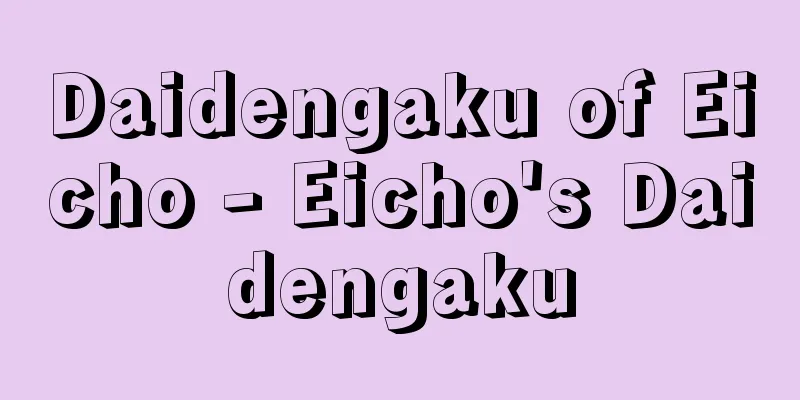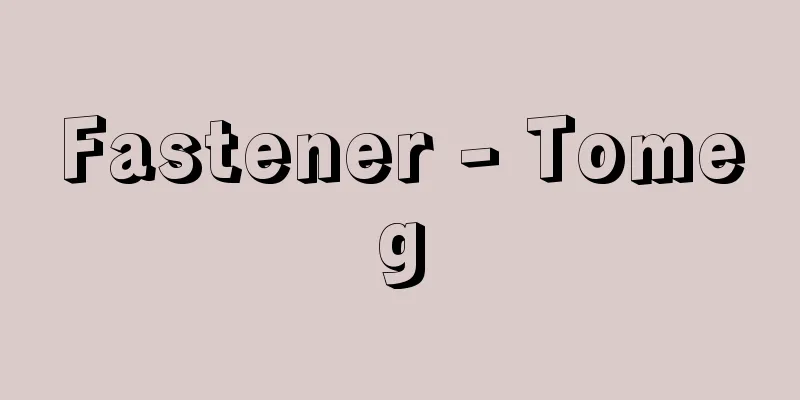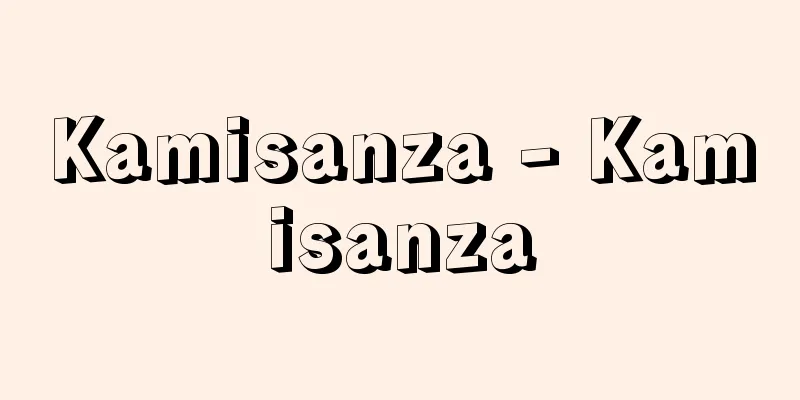Renga - Brick

|
Short renga, which was popular during the Heian period, and long renga, which was popular from the Kamakura period to the early Edo period, were both called renga at the time, but the term generally refers to the latter. It is a type of poetry unique to the Middle Ages that arose and died out with the Middle Ages. [Kito Saizō] Form and formatIn short renga, one author adds a 7-7 verse to a 5-7-5 verse, or a 5-7-5 verse to a 7-7 verse, completing the poem. In the Yakumo Misho, this form is called ikku renga. It is a poem sung by two people in unison, but some were written with the intention of two people working together to create a single waka poem. In contrast, cho renga is a poem in which a 7-7 verse is added to a 5-7-5 verse, and then another 5-7-5 verse is added to that, alternating between long and short verses until a certain number is reached. During the Insei period, it was called kusari renga, and after the Kamakura period, 100 verses became the standard. Ten volumes of 100 verses were called sen ku, and ten volumes of 1,000 verses were called man ku. Renga poems of less than 100 verses, such as 50-verse, Yoyoshi (44 verses), and Kasen (36 verses), were also occasionally performed. A hundred verses are usually composed by a group of anywhere from a few to a dozen people, and the participants are called a congregation or a group of participants. In rare cases, a poem may be composed by one, two, or three people, and each is called a solo poem, two verses, or three verses. The format for writing down a hundred verses was to use four pieces of origami paper (a type of kaishi folded in half horizontally), with eight verses on the front and fourteen verses on the back in the first fold (shoori), fourteen verses on each side in the second and third folds, and fourteen verses on the front and eight verses on the back in the fourth fold (nagori no ori). The rules of renga in its mature period were built on this format. The first verse of a cho renga is called hokku, the next verse is called wakiku, the next verse is called the third and last verse is called ageku (gaku), and the rest are called hiraku. Hokku were composed by seasoned poets, guests, and nobles in the troupe, and were meant to describe the scenery of the time. Hokku are independent in both form and content, but wakiku and the following verses are attached to the verse before them, and only when combined with the verse before them do they form a single verse boundary. [Kito Saizō] Essence and FeaturesRenga is a form of poetry written collaboratively by several or more participants, but as a whole it does not express any coherent thought or content. When a hokku (first verse) is recited at a renga gathering, the participants think of a suitable side verse for it, and when the side verse is presented, they imagine the world that the hokku and side verse compose, immersing themselves in that world and soaking in its beauty. Next, they think of a third verse that suits the side verse, and when the third verse is presented, they imagine the world that the side verse and third verse compose, immersing themselves in that world. And they think of a fourth verse, and so on. As they repeat the process of appreciation and composition, the state of the poem shifts from spring to autumn, from autumn to love, and from love to reminiscence, with no end in sight. Renga is a literary art that aims to savor the fascinating aspects of such mental processes, and what is written down on the kaishi merely shows the trajectory of this poetic experience. There were various ways to connect the previous verse and the attached verse, ranging from those that use the material or the edge of words as a clue to connect them, to extremely advanced connections that sympathize with one image and another, and there were also various ways to develop the entire volume that heightened artistic excitement. All of these were able to achieve aesthetic effects by following the dictates of the Renga Shikimoku, which stipulates the frequency, intervals, and connecting methods of the materials used in a volume. This type of unique poetry became popular in the Middle Ages because renga freed people's minds from the harsh reality of times of chaos and enabled true spiritual exchange between people through elegant recreation. However, renga was not simply a form of spiritual relaxation or social interaction; it was also performed for Buddhist rituals, prayers, congratulations, memorials, or when people came up with verses to express their dreams. There were many different types of renga, including ordinary renga, kamuriji renga, in which the 47 letters of the Iroha or the name of a god or Buddha are written at the beginning of each verse, monona renga, in which the names of things, phrases, famous places, and other things are written in each verse, and palindrome renga, which imitates the palindrome of waka poetry. [Kito Saizō] Establishment and evolutionThe idea that the chant between Yamato Takeru no Mikoto and Hitomoshibito, found in the "Nihon Shoki," - "After the skylark passed Tsukuba, I slept for several nights," and "Day after day, nine nights and ten days," is the origin of renga, has been around since the mid-Kamakura period, but this is a question and answer session using katauta (single verse), and the oldest example of a chant using the first and second verses of a waka poem is the chant between a nun and Otomo no Yakamochi, found in Volume 8 of the "Man'yoshu," - "The rice fields we planted by damming the waters of the Saho River will be harvested together, and the first rice we eat will be eaten alone." This type of short linked verse was popular from the mid to late Heian period, and is included in imperially commissioned waka anthologies such as "Gosen Wakashu," "Shuui Wakashu," and "Kin'yo Wakashu." In the Insei period, long renga (chain renga) began to be performed in parallel with short renga. In the early Kamakura period, long renga became popular among the Shin Kokin poets, including Fujiwara Teika and Ietaka, who were centered around Emperor Gotoba, and gradually it became more literary and well-formed, with 100 verses becoming the standard format. After that, renga became increasingly popular among the aristocrats of the Kamakura period, especially the descendants of Teika, and in the mid-Kamakura period, various rites were established, culminating in the establishment of the "Kenji style," which served as the standard even during the Nanboku-cho period. Renga also became popular among the general public in the mid-Kamakura period, and renga gatherings were held in March under the cherry blossoms of Bishamon-do, Hossho-ji, Kiyomizu-dera, and other temples in Kyoto, under the guidance of underground renga masters such as Dosho, Jakunin, and Musho. This was called hana no shita moto renga, and it became increasingly grand in the late Kamakura period, with aristocrats such as retired emperors and regents participating in the gatherings. Zen'a was the most prominent underground renga master in the late Kamakura period, but from the end of the Kamakura period to the beginning of the Northern and Southern Courts, underground renga rapidly improved in literary quality, centered around underground renga masters such as Shinsho, Junkaku, Kyusei, and Ryoa, who were Zen'a's disciples. Among them, Kikushi became the teacher of Nijō Yoshimoto, and cooperated with Yoshimoto in editing the quasi-imperial anthology of linked verse, Tsukubashu (1356), and further revised and expanded the Kenjishiki (1372), Oan Shinshiki (1372). Yoshimoto also wrote Renri Hisho (1341), Tsukuba Mondo (1346), and other treatises on linked verse, showing the ideal of linked verse composition. In this way, linked verse established its position as the poetry representing the new era, replacing waka, but the distinctive style of linked verse from the Northern and Southern Dynasties was that it aimed for mysterious beauty in a powerful style that contained the eccentric character unique to underground linked verse. As a writer, Kyu was outstanding, composing verses such as "This is the end of separation. The rain-scattered flowers in the evening, the mountain winds" (Fukuku). In the late Northern and Southern Courts period, Kyu's disciple Shua rapidly rose to prominence, and a style of verse that was elaborate in its tailoring and had noticeable techniques became popular. The influence of the Shua school was also strong in the world of renga in the early Muromachi period, and renga began to lose its literary value. During this period, Bonto, a disciple of Yoshiki, held a central position in the world of renga, but his works were unable to escape the trends of the time. However, in the mid-Muromachi period, Sozei and Chiun, who had studied under the Reizei school poet Shotetsu, emerged and revived the ushin and yugen style of renga, which incorporated the beauty of the court classics into renga. Their juniors, such as Shinkei, Senjun, and Noa, further deepened this state of mind, and renga reached a period of literal perfection. During this period, Ichijo Kaneyoshi, with the cooperation of Sosuke, compiled the Shinshiki Konan (1452), an expanded and revised version of the Oan Shinshiki, and Shinkei left behind elegant works such as "The flowers that fall in the dawn moon, where it is difficult to tell whether they are dreaming or waking, are of this world" (fuku), which were based on the idea of impermanence and aimed for a new beauty of ancient and modern times. On the other hand, he also wrote Sasamegoto and other works on renga, which explored the true nature of poetry and methods of expression in the Middle Ages, and even the way of life of a poet. Sogi, who was taught by Souke, Shinkei, and Senjun and was well versed in the classics, refined a volume of renga into a true poem by summarizing the styles of his predecessors, and left behind perfect works such as "Minase Sangin Hyakuin" (1488) together with his disciples such as Shohaku and Socho. On the other hand, he compiled "Chikurinsho", a collection of poems by seven predecessors including Souke and Shinkei, and "Shinsen Tsukubashu" (1495), a quasi-imperial anthology of renga, with the help of Kensai and others. He also wrote many treatises on renga that were useful for practical instruction, such as "Azuma Mondo" and "Roi no Susami". With the high achievements of the Sogi period as a backdrop, in 1501 (Bunki 1), Shohaku revised and expanded Renga Shinshiki on a large scale, which had a major impact on the establishment of the Shikimoku (code of rules for haikai poetry). After Sogi died and Kanezai, who was second in rank to Sogi, retired to Kanto, the central figures in the renga world were Shohaku, Socho, and Soseki, all of whom were disciples of Sogi, but after their deaths Soboku and Shukei, also of Soseki, took center stage in the renga world, followed by Shokyu, also of Soboku, and Soboku's son Soyo, and after their deaths Shoha, also of Shokyu, who occupied leading positions in the renga world. During the Azuchi-Momoyama period, as the long years of turmoil came to an end and the number of people who enjoyed renga increased, the style of renga became simpler and it became more of a social tool. Then, in the Edo period, the descendants of Shoha and Shokyu's son Shoshitsu both took the name Satomura and inherited the position of renga master for the shogunate, and renga finally entered an era of fixation. [Kito Saizō] "Japanese Classical Literature Series 39: Renga Collection," edited by Ijichi Tetsuo (1960, Iwanami Shoten)" ▽ "The World of Renga, by Ijichi Tetsuo (1967, Yoshikawa Kobunkan)" ▽ "Study of Renga, by Shimazu Tadao (1973, Kadokawa Shoten)" ▽ "Study of the Tokuba Collection, by Kaneko Kinjiro (1965, Kazama Shobo)" ▽ "Study of the Newly Selected Tokuba Collection, by Kaneko Kinjiro (1969, Kazama Shobo)" ▽ "Considerations on the History of Renga, Volumes 1 and 2, by Kito Saizō (1971, 1973, Meiji Shoin)" ▽ "General Theory of Renga, by Kaneko Kinjiro (1987, Ohfusha)" [Reference items] | | |Source: Shogakukan Encyclopedia Nipponica About Encyclopedia Nipponica Information | Legend |
|
平安朝時代に主として流行した短(たん)連歌と、鎌倉時代から江戸時代初期にかけて流行した長(ちょう)連歌を、その当時においては、ともに連歌とよんでいたが、一般には後者をさす。それは中世とともにおこり、中世とともに滅んだ、中世特有の詩である。 [木藤才蔵] 形態と書式短連歌は、五七五の前句に別の作者が七七の句を付けるか、あるいは、七七の前句に五七五の句を付けて完結させるもので、『八雲御抄(やくもみしょう)』では、こうした形式のものを一句(いっく)連歌とよんでいる。両人による唱和の詩というべきものであるが、一首の和歌を2人で合作するという意識で詠まれたものもある。それに対して、長連歌は、五七五の句に七七の句を付け、それにさらに五七五の句を付けるというふうにして、長句と短句を交互に付けて一定数に至るもので、院政時代には鎖(くさり)連歌とよばれ、鎌倉時代以後は百韻(100句)が定型とされた。この百韻十巻を千句、千句十巻を万句といった。また、百韻に満たない、五十韻、世吉(よよし)(44句)、歌仙(かせん)(36句)などの形式の連歌もときおり行われていた。 百韻は数人から十数人の人数で制作するのが普通であるが、その参会者を会衆(かいしゅう)とか連衆(れんじゅう)という。まれには1人、2人、3人などで詠む場合もあり、それぞれを独吟、両吟、三吟などとよんだ。百韻を書き留める書式としては、懐紙を横に半折した折紙(おりがみ)四枚を用いて、一(いち)の折(初折(しょおり))の表に8句、裏に14句、二、三の折は表・裏ともに14句ずつ、四の折(名残(なごり)の折)には、表に14句、裏に8句を記すことになっていた。完成期の連歌の規則は、こうした書式のうえに組み立てられていた。 長連歌の最初の句を発句(ほっく)、その次の句を脇句(わきく)、その次の句を第3、最後の句を揚句(あげく)(挙句)、その他の句を平句(ひらく)といい、発句は一座のなかの練達の士、客人、高貴の人などが詠み、その時節の景物を詠み込むものとされていた。発句は句形のうえでも内容のうえでも独立しているが、脇句以下は、その前の句に付けて、前句とあわせて初めて一つの句境を構成するのである。 [木藤才蔵] 本質・特徴連歌は数人以上の参会者による合作の詩というべきものであるが、全体としてはなんらまとまった思想も内容も表現しない。連歌の会席で発句が詠み上げられると、参会者はその発句にふさわしい脇句を考え、脇句が提示されると、発句と脇句の構成する世界を思い浮かべて、その世界に没入しその美にひたる。ついで、脇句にふさわしい第三の句を考え、第三の句が提示されると、脇句と第三の句の構成する世界を思い浮かべて、その世界に没入する。そしてさらに、第四の句を考えるというふうにして、鑑賞と制作を繰り返しているうちに、句境は春から秋に、秋から恋へ、恋から述懐へと移り変わっていって極まるところがない。連歌はこうした心的過程のおもしろさを味わうことを目的とした文芸であって、懐紙に書き留められたものは、こうした詩的体験の軌跡を示すものにすぎないのである。 前句と付句の連接の仕方には、素材やことばの縁を手掛りにして付けるものから、イメージとイメージとを交響させる、きわめて高度の付合(つけあい)に至るまで、各種の付け方があり、一巻全体の展開のさせ方にも、芸術的な感興を高める諸種の行様(ゆきよう)があった。それらはすべて、一巻に用いる素材の出度数や間隔や連接の仕方を規定した連歌式目(しきもく)の示すところに則(のっと)ることによって、美的効果を発揮することができたのである。 こうした特殊の詩が中世に流行したのは、連歌の場が、乱世の過酷な現実から人々の心を開放し、風雅に遊ぶことによって、人と人との精神の真の交流を可能にしたからである。しかし、連歌は単なる心の慰みや社交のためだけではなく、諸神への法楽や祈願、祝言、追悼、あるいは夢想の句を得た場合などにも行われた。その種類もさまざまで、普通の連歌のほかに、いろは47文字や神仏の名号などをそれぞれの句の句頭に詠み入れた冠字(かむりじ)連歌、それぞれの句に物の名や熟語や名所その他を詠み込んだ物名(もののな)連歌、和歌の回文(かいぶん)をまねた回文連歌なども行われていた。 [木藤才蔵] 成立と変遷『日本書紀』所載の日本武尊(やまとたけるのみこと)と秉燭者(ひともしびと)との唱和、「にひばり筑波(つくば)を過ぎて幾夜か寝つる」「日日並(かかな)べて夜(よ)には九夜(ここのよ)日には十日を」を連歌の起源とする考え方が鎌倉中期以後行われているが、これは片歌(かたうた)による問答であって、和歌の上句と下句による唱和としては、『万葉集』巻八にみえる、尼と大伴家持(おおとものやかもち)との唱和「佐保(さほ)川の水を堰(せ)き上げて植ゑし田を/刈れる初飯(はついひ)はひとりなるべし」がもっとも古い。この短連歌は、平安朝中期から後期に盛行し、『後撰(ごせん)和歌集』『拾遺(しゅうい)和歌集』『金葉(きんよう)和歌集』などの勅撰和歌集にも入集(にっしゅう)している。 院政時代に入ると、この短連歌と並行して長連歌(鎖連歌)が行われるようになる。鎌倉初期になって後鳥羽(ごとば)院を中心とする藤原定家(ていか)、同家隆(いえたか)その他の新古今歌人の間で、この長連歌が愛好されたため、しだいに文芸性の高いものになり、形式も整って、百韻をいちおうの定型とするようになった。それ以後、鎌倉時代の貴族の間では、定家の子孫たちを中心にして、連歌はますます愛好され、鎌倉中期になると、各種の式目が制定され、南北朝期においても規準とされた「建治(けんじ)式」が成立する。また、鎌倉中期には一般庶民の間でも連歌が流行し、3月の桜の花の盛りに、京都の毘沙門堂(びしゃもんどう)、法勝寺(ほっしょうじ)、清水寺(きよみずでら)などの花の下で、道生(どうしょう)、寂忍(じゃくにん)、無生(むしょう)などの地下(じげ)連歌師の指導のもとに、連歌会が開催された。花(はな)の下(もと)連歌がこれで、鎌倉末期にはますます盛大となり、その会には上皇や関白などの貴族も参加している。鎌倉後期の地下連歌師のなかで最大の存在は善阿(ぜんあ)であるが、鎌倉末期から南北朝初期にかけて、善阿門下の信照(しんしょう)、順覚(じゅんかく)、救済(きゅうせい)、良阿(りょうあ)などの地下連歌師を中心にして地下連歌は急速に文芸性を高めていった。そのなかでも救済は二条良基(よしもと)の師となり、良基に協力して、准勅撰の連歌の撰集『菟玖波(つくば)集』(1356)を編集し、さらに「建治式」に改訂増補を加えた『応安(おうあん)新式』(1372)を制定している。良基はその一方において、『連理秘抄(れんりひしょう)』『筑波(つくば)問答』その他の連歌論書を著作して、連歌の句作の理想を示している。このようにして連歌は、和歌にかわって新時代を代表する詩としての地位を確立していくのであるが、南北朝連歌の句風の特色は、地下連歌に特有の奇知的性格を内包した、力強い句風のうちに、幽玄(ゆうげん)の美を指向している点にあった。作家としては救済が卓絶しており、「わかれはこれぞ限りなりける 雨に散る花の夕(ゆふべ)の山おろし」(付句)のような句をつくっている。南北朝後期に入ると、救済の門弟の周阿(しゅうあ)が急速に頭角を現し、一句の仕立てに趣向を凝らした、技巧の目につく句風が流行するようになる。 室町初期の連歌界においても、周阿の亜流の影響は強く、連歌は文芸性を喪失していく。この時代に連歌界の中心的地位にあったのは良基門下の梵灯(ぼんとう)であったが、その作品も時代の風潮から抜け出ることはできなかった。ところが、室町中期に入って、冷泉(れいぜい)派の歌人正徹(しょうてつ)の教えを受けた宗砌(そうぜい)や智蘊(ちうん)が出て、王朝古典の美を連歌に生かした有心(うしん)・幽玄の句風を復興し、さらにその後輩にあたる心敬(しんけい)、専順(せんじゅん)、能阿(のうあ)などの作家によって、その境地がいっそう深められるに及び、連歌は文字どおりの完成期を迎えることになる。この時期に、一条兼良(かねら)は宗砌の協力を得て、『応安新式』に増補改訂を加えた『新式今案(こんあん)』(1452)を制定しているし、心敬は、無常観を根底に据え新古今美を指向した「夢うつつとも分かぬあけぼの 月に散る花はこの世のものならで」(付句)のような優艶(ゆうえん)な作品を残している一方において、中世における真の詩のあり方や表現の仕方、さらには詩人の生き方をも追求した『ささめごと』その他の連歌論書を著作している。 宗砌、心敬、専順に教えを受け、古典にも深く通じていた宗祇(そうぎ)は、先達の作風を集大成して連歌一巻を真の詩にまで鍛え上げ、肖柏(しょうはく)、宗長(そうちょう)などの門弟たちと、『水無瀬三吟(みなせさんぎん)百韻』(1488)のような完璧(かんぺき)の作品を残している。その一方において、宗砌、心敬など7人の先達の句を集めた『竹林抄(ちくりんしょう)』を独力で、准勅撰の連歌の撰集『新撰菟玖波集』(1495)を兼載(けんさい)その他の人々の協力を得て編集しているほか、『吾妻(あづま)問答』『老のすさみ』その他、実地指導に役だつ数多くの連歌論書をも著作している。この宗祇時代の高い達成を背景にして、1501年(文亀1)には、肖柏によって、『連歌新式』の大規模な増補改訂が行われ、これは俳諧(はいかい)の式目の成立にも大きな影響を与えた。宗祇が没し、宗祇に次ぐ存在であった兼載が関東に退隠してのち、連歌界の中心的位置にあったのは、宗祇門下の肖柏、宗長、宗碩(そうせき)などであったが、その没後には宗碩門下の宗牧(そうぼく)や周桂(しゅうけい)が連歌界の中心に位置し、さらにその後を受けて、宗牧門下の昌休(しょうきゅう)や宗牧の子の宗養が、その没後には昌休門下の紹巴(じょうは)が連歌界の指導的位置を占める。 安土(あづち)桃山時代には、多年にわたる乱世の終局と享受層の増大につれて、連歌の句風は平易なものになり、社交の具としての性格をいっそう強めてゆく。ついで江戸時代になると、紹巴と昌休の子昌叱(しょうしつ)との子孫が、ともに里村を名のって幕府の連歌師の職を世襲し、連歌はようやく固定化の時代に入るのである。 [木藤才蔵] 『伊地知鉄男校注『日本古典文学大系39 連歌集』(1960・岩波書店)』▽『伊地知鉄男著『連歌の世界』(1967・吉川弘文館)』▽『島津忠夫著『連歌の研究』(1973・角川書店)』▽『金子金治郎著『菟玖波集の研究』(1965・風間書房)』▽『金子金治郎著『新撰菟玖波集の研究』(1969・風間書房)』▽『木藤才蔵著『連歌史論考』上下(1971、1973・明治書院)』▽『金子金治郎著『連歌総論』(1987・桜楓社)』 [参照項目] | | |出典 小学館 日本大百科全書(ニッポニカ)日本大百科全書(ニッポニカ)について 情報 | 凡例 |
<<: Brick - Brick (English spelling)
Recommend
Indigo juice - Aishiru
〘Noun〙 Indigo leaves are dried, soaked in water to...
Tosashimizu [city] - Tosashimizu
A city in the southwest of Kochi Prefecture. It wa...
Seven children - Nanatsugo
The name of a piece of Japanese performing arts or...
Kakashiage - Kakashiage
...There are also folk examples of scarecrows bei...
Disease structure
It refers to the cause, course, and symptoms of a ...
Indirect evidence - Indizienbeweis; circumstantial evidence
In criminal proceedings, circumstantial evidence i...
Sugita Teiichi
Year of death: March 23, 1929 (Showa 4) Year of bi...
Rooftop Garden
…In 1907, he became a member of the magazine &quo...
Thyroid-stimulating hormone
…Thyroid-stimulating hormone, also known as thyro...
Tomakomai [city] - Tomakomai
A city in central-southern Hokkaido. It was incorp...
sloop
…One of the styles widely used in modern yachts, ...
joint replacement
...That is, the intermediate membrane, fascia, jo...
Zonal structure
A discontinuous banded structure formed by differe...
Romantische Strasse (English spelling)
The name of the road stretching about 300 km south...
The Consolation of Philosophy - De consolatione philosophiae
Boethius' last work. In 523, he was dismissed ...









